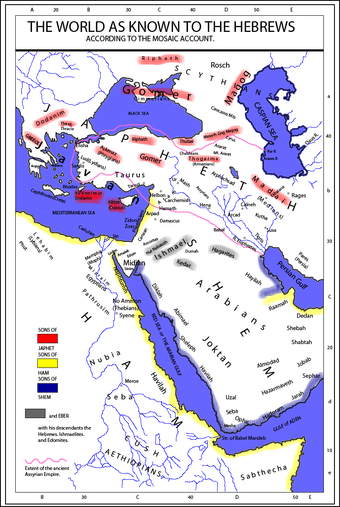Togarmah
Togarmah (Hebrew: תֹּגַרְמָה Tōgarmā[h]; Armenian: Թորգոմ T’orgom) is a figure in the "table of nations" in Genesis 10, the list of descendants of Noah that represents the peoples known to the ancient Hebrews. Togarmah is among the descendants of Japheth and is thought to represent some people located in Anatolia. Medieval traditions variously claimed Togarmah as the mythical ancestor of peoples in the Caucasus and western Asia, including the Georgians, the Armenians and some Turkic peoples (i.e. Oghuzes, Khazars).

Biblical attestations and historical geography
Togarmah is listed in Genesis 10:3 as the third son of Gomer, and grandson of Japheth, brother of Ashkenaz and Riphath. The name is again mentioned in the book of Ezekiel as a nation from the "far north". Ezekiel 38:6 mentions Togarmah together with Tubal as supplying soldiers to the army of Gog. Ezekiel 27:14 mentions Togarmah together with Tubal, Javan and Meshech as supplying horses to the Tyrians.
Most scholars identify Togarmah with the capital city called Tegarama by the Hittites and Til-Garimmu by the Assyrians.[1] O.R. Gurney placed Tegarama in Southeast Anatolia.[2]
Later traditions
Several later ethnological traditions have claimed Togarmah as the mythical ancestor of various peoples located in western Asia and the Caucasus. Jewish historian Flavius Josephus (37 – c. 100 AD) and the Christian theologians Jerome (c. 347 – 420 AD) and Isidore of Seville (c. 560 – 636 AD) regarded Togarmah as the father of the Phrygians. Several ancient Christian authors, including Saint Hippolytus (c. 170-c. 236 AD), Eusebius of Caesarea (c. 263 – c. 339 AD), and bishop Theodoret (c. 393 – c. 457 AD), regarded him as a father of Armenians. Medieval Jewish traditions linked him with Turkic peoples including the Khazars.
Armenian and Georgian traditions
The order of the figures from left to right is: Movakan, Bardos, Kartlos, Haos, Lekos, Thargamos, Caucas, Egros. An opening folio of the Georgian Chronicles (Vakhtangiseuli redaction), 1700s.
Another Togarmah, this one being the son of both Tiras and Gomer, is mentioned by Armenian Moses of Chorene (c. 480) and Georgian Leonti Mroveli who regarded Togarmah as the founder of their nations along with other Caucasian people.
According to Moses of Chorene's History of Armenia and to Leonti Mroveli's medieval Georgian Chronicles, "Thargamos" was thought to have lived in Babylon, before he received the "land between two Seas and two Mountains" (i.e. the Caucasus) in his possession. He then settled near Mount Ararat and divided his land among his sons:[3][4]
- Haik (Հայկ) - first son of Thargamos, inherited Mount Ararat and founded the Armenian nation.
- Kartlos (ქართლოსი) - settled in north-east from Ararat, founder of Kartli (Sa'kartvelo) who united other brothers and founded the Georgian nation.
- Bardos
- Movakos (Movkans)
- Lekos
- Heros (Herans) - settled in the eastern part of Ararat
- Caucas (Kovkases) - settled beyond the Caucasus Range
- Egros (Egers) - settled between the Black Sea and Likhi Range (Western Georgia)
Jewish traditions
Togarmah was linked to medieval Turkic peoples by Jewish-Khazar traditions. The Khazar ruler Joseph ben Aaron (c. 960) writes in his letters:
- "You ask us also in your epistle: "Of what people, of what family, and of what tribe are you?" Know that we are descended from Japhet, through his son Togarmah. I have found in the genealogical books of my ancestors that Togarmah had ten sons."
He then goes on to enumerate ten names that can be identified as contemporary tribes living near the Black and Caspian Seas:[5][6] "Ujur" (Uyghur), "Tauris" (Tauri), "Avar" (Avar), "Uguz" (Oghuz), "Bizal", "Tarna", "Chazar" (Khazar), "Janur", "Bulgar" (Bulgar) and "Sawir".
The medieval Jewish Joseph ben Gorion lists the ten sons of Togarmas in his Josippon as follows:
- Kozar (the Khazars)
- Pacinak (the Pechenegs)
- Aliqanosz (the Alans)
- Ragbiga (Ragbina, Ranbona)
- Turqi (possibly the Kökturks)
- Buz (the Oghuz)
- Zabuk
- Ungari (either the Hungarians or the Oghurs/Onogurs)
- Tilmac (Tilmic/Tirôsz - Tauri)."
In the Chronicles of Jerahmeel, they are listed as:
- Cuzar (the Khazars)
- Pasinaq (the Pechenegs)
- Alan (the Alans)
- Bulgar (the Bulgars)
- Kanbinah
- Turq (possibly the Kökturks)
- Buz (the Oghuz)
- Zakhukh
- Ugar (either the Hungarians or the Oghurs/Onogurs)
- Tulmes (Tirôsz - Tauri)
Another medieval rabbinic work, the Book of Jasher, give the names:
Other traditions
In an 11th-century Arabic translation of Josippon by a Yemenite Jew,[7] Togorma's tribes are these:
- Khazar (the Khazars)
- Badsanag (the Pechenegs)
- Asz-alân (the Alans)
- Zabub
- Fitrakh (Kotrakh?) (Ko-etrakh. Etrakh means Turks [possibly Gokturks])
- Nabir
- Andsar (Ajhar)
- Talmisz (Tirôsz - Tauri)
- Adzîgher (Adzhigardak?).
The Arabic account however, also adds an 11th clan: Anszuh.
In the 18th century, the French Benedictine monk and scholar Calmet (1672–1757) placed Togarmah in Scythia and Turcomania (in the Eurasian Steppes and Central Asia).[8]
References
- "Gen. 10:3 identifies Togarmah (along with Ashkenaz and Riphath) as the son of Gomer and the nephew of Javan, Meshech, and Tubal. Most scholars equate the name with the capital of Kammanu (Kummanni), known in Hittite texts as Tegarama, in Akkadian as Til-garimmu, and in classical sources as Gauraen (modern Gurun)." Daniel I. Block (19 June 1998). The Book of Ezekiel, Chapters 25 48. Wm. B. Eerdmans Publishing. pp. 73–74. ISBN 978-0-8028-2536-0.
- map on inside cover of Gurney, The Hittites, Folio Society edition
- "The Georgian Chronicle, History". Rbedrosian.com. Retrieved 2015-07-26.
- "Мовсес Хоренаци, История Армении в трех частях. Книга Первая". Vehi.net. Retrieved 2015-07-26.
- Bloomberg, Jon: The Jewish World in the Middle Ages. Ktav Publishing, 2000, p. 108.
- Pritsak O. & Golb. N: Khazarian Hebrew Documents of the Tenth Century, Ithaca: Cornell Univ. Press, 1982.
- Abhandlungen der Akademie der Wissenschafien in Go'ttingen, Philolagisch-Historische Klasse [Neue Folge 1.4; Berlin, 1897].J. Wellenhausen. "'Der arabische Josippus'". Akademie der Wissenschafien in Go'ttingen.
- The Encyclopedia of Religious Knowledge. (1835) B. B. Edwards and J. Newton Brown. Brattleboro, Vermont, Fessenden & Co., p. 1125.